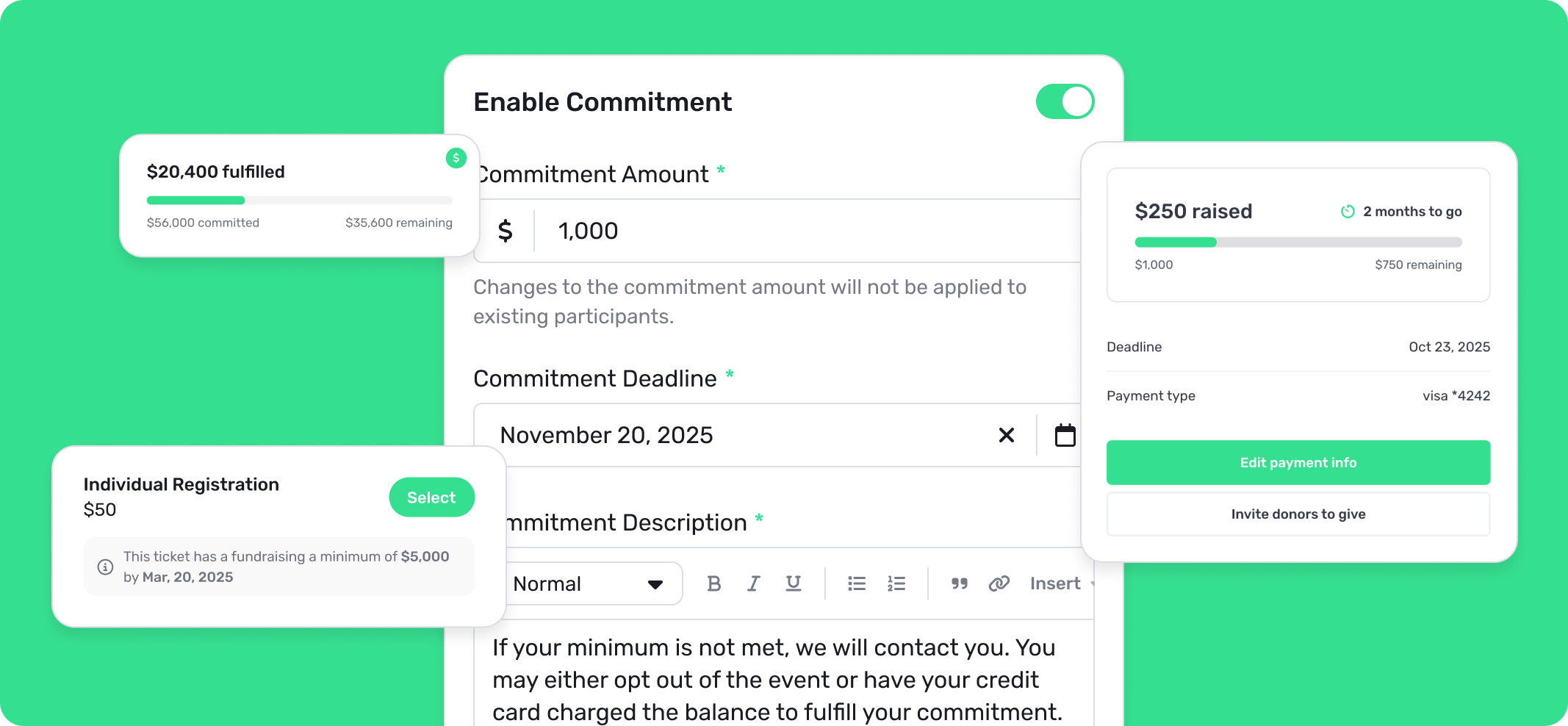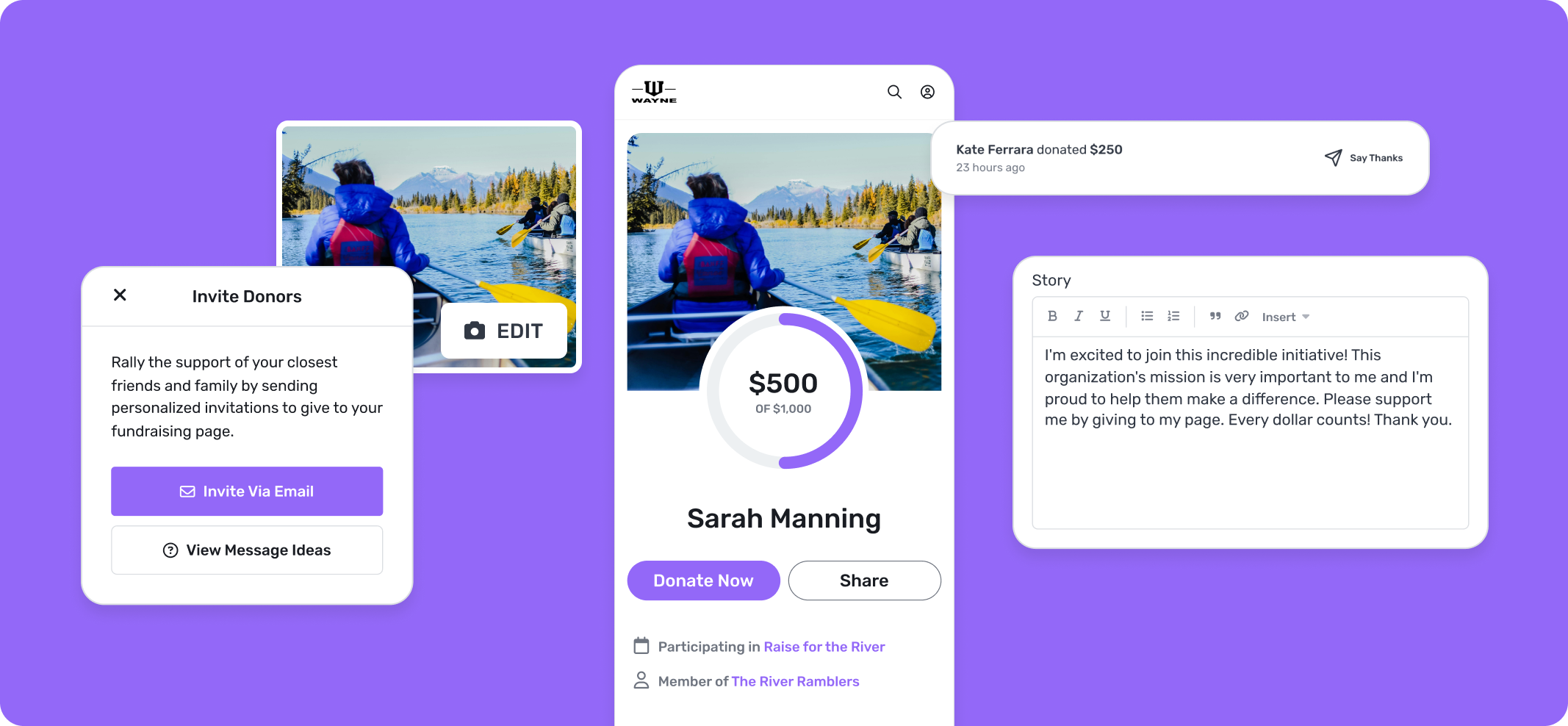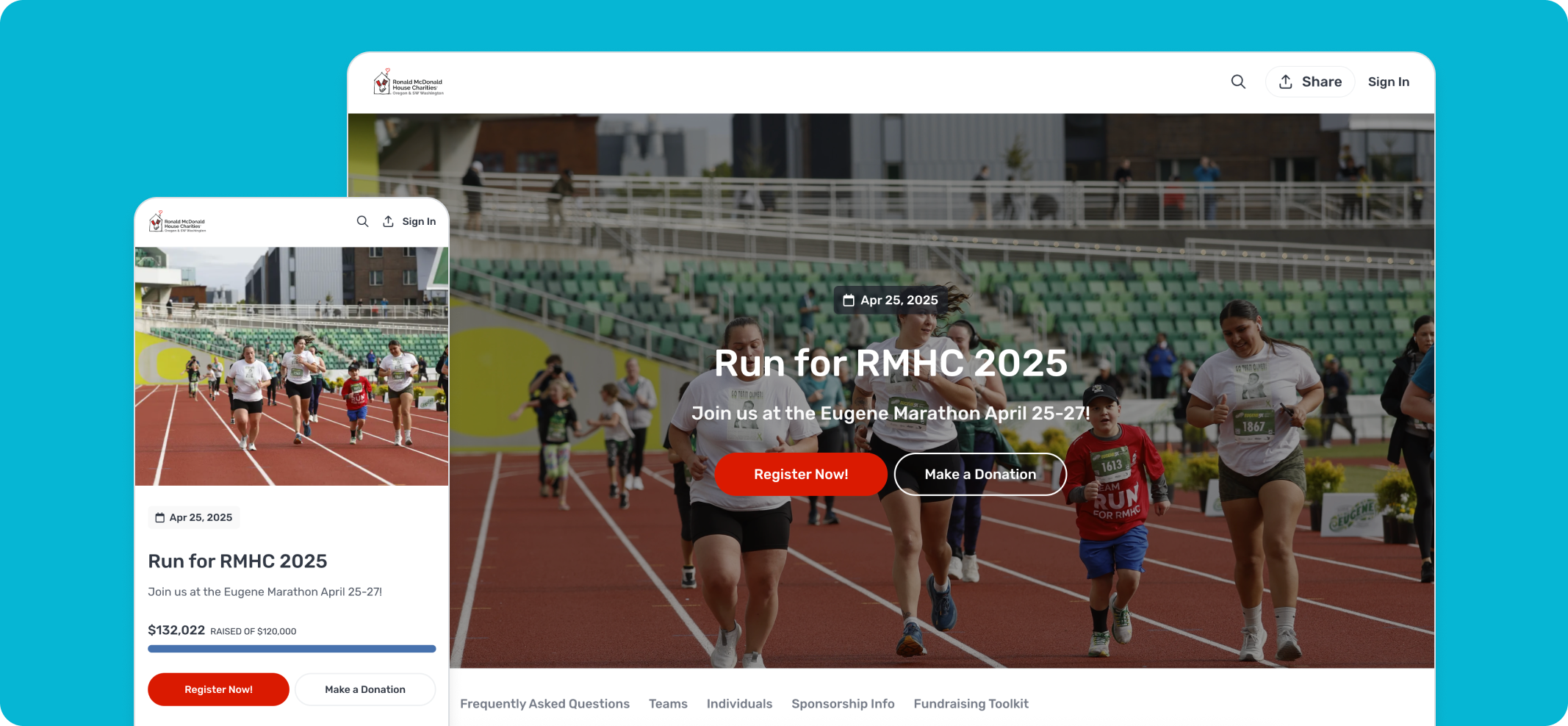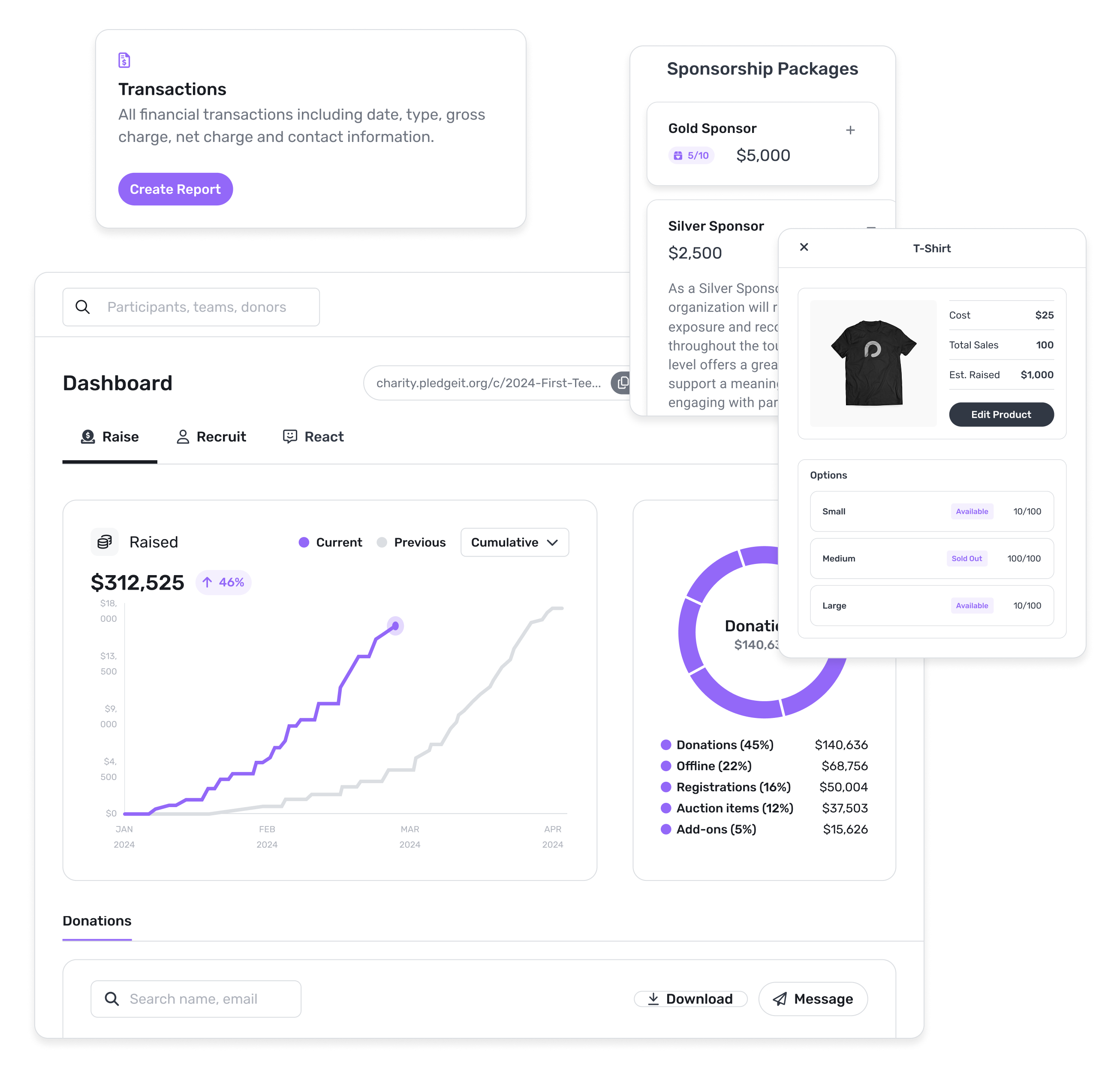Peer-to-peer fundraising allows supporters to raise money for your cause by reaching out to their friends, family, and colleagues.
In 2024, peer-to-peer campaigns grew 18% in volume, but the dollars per participant fell 20% to $159. Without a strategy that supports your fundraisers or energizes your community, these efforts can lead to diminishing returns.
That’s why focusing on the quality of your campaigns is so important.
In this guide, we cover common peer-to-peer (P2P) fundraising mistakes and the strategies that successful nonprofits use to nurture a dedicated community of supporters. We’ll talk about recruiting the right people, implementing effective engagement methods, and providing storytelling tools and templates fundraisers can use time and time again.
What Is P2P Fundraising?
Traditional fundraising involves appealing directly to your supporters and potential donors. P2P fundraising turns supporters into ambassadors who advocate on your behalf and expand your reach by sharing your mission with their friends and family.
P2P fundraising works especially well for fundraising events like charity runs, walk-a-thons, and virtual challenges, where participants can leverage their personal networks to drive both attendance and donations.
The benefits of P2P fundraising extend far beyond revenue generation. They:
- Provide an inclusive community where P2P fundraisers feel aligned, empowered, and supported by your organization to raise more awareness for your cause
- Expand your donor base through authentic interactions and higher response rates from people they know and trust
- Reach broader audiences through warm introductions
- Creates lasting engagement that extends beyond individual campaigns
With 76% of registrants who became active fundraisers in 2024, P2P fundraising appeals to supporters who want to do more than donate. Successful nonprofits treat peer-to-peer fundraising as an extension of their active community that transforms supporters into champions of change.
Why P2P Strategy Matters
Without a strategy, supporters struggle to fundraise on their own, leading to burnout and, worse, campaign abandonment. Strategic planning equips your team and fundraisers for success while expanding your donor base, lowering acquisition costs, and raising more per participant.
You don’t even need a huge team to accomplish this. By creating scalable systems, documenting steps, providing easy resources, and automating outreach, fundraisers can simply do what they signed up for.
Peer-to-Peer Fundraising Dos
Successful peer fundraising efforts require more than just launching a campaign and hoping for the best. Whether you're organizing fundraising events, virtual challenges, or ongoing campaigns, these proven strategies will encourage fundraisers to take meaningful action and achieve exceptional results. Set the stage for success with campaign fundamentals that turn supporters into confident ambassadors who are equipped, motivated, and ready to expand your mission's reach.
Have a Clear, Concise Call to Action
Make it easy for fundraisers to know exactly what you’re asking them to do. Instead of vague appeals like “support our cause,” use specific action-oriented language: “Raise $500 to fund five nights of housing for families in crisis.” This helps fundraisers communicate your mission clearly to their networks and inspires donors to give.
Recruit Motivated Participants Early
Recruit your biggest advocates—dedicated volunteers, vocal supporters, or consistent donors—a few months before you launch your campaign. Personal outreach through calls, emails, and meetings makes supporters feel like VIPs who play an important role in spreading your mission and creating a positive impact.
Equip Fundraisers With Great Tools
The right tools, like the right people, are part of the foundation for successful fundraising. The best peer-to-peer campaigns make fundraising simple and set participants up for success from the start.
With Pledge It's user-friendly platform, fundraisers can easily customize their pages and start bringing in donations. For more intensive P2P campaigns like large cycling events, races, charity bib events or other endurance activities where participants need stronger commitment levels, you can enable fundraising minimums to establish baseline commitment amounts and collect payment methods during signup. Because these events often require additional planning and logistics, a fundraising commitment ensures your event will raise a set amount of funds to help cover event costs or meet specific targets.

Added bonus: Create an onboarding toolkit with helpful tips, instructional videos, and messaging templates for different audiences, whether family, friends, coworkers, or social media followers. A prepared fundraiser is a confident fundraiser, and confident fundraisers raise more.
Tell Clear, Emotional Stories
Compelling stories about real people you’ve helped resonate more than graphs and statistics. Stories fuel deep conversations, emotional connections, and strong ties to your organization.
Create story templates that fundraisers can tailor to their target audience. Some supporters are drawn to individual transformation stories, while others resonate with community-wide impact. These templates can include real examples (approved photos, quotes, or milestones) that they can make their own and share authentically.
Make Registration Easy for Your Peer-to-Peer Fundraising Campaigns
A complex registration process can frustrate participants, causing them to abandon the registration process. Keep the form short and sweet. A good rule of thumb is to collect enough information to get them started, such as contact information and fundraising goals. The faster fundraisers create their page, the more likely they are to take action.
With Pledge It, you can simplify this process even further by applying branded templates—logos, colors, imagery, and messaging are already built in—so every participant’s experience feels cohesive and mission‑aligned from the moment they sign up.
After they register, equip them with social media templates, email templates, and graphics, and include direct links to their fundraising page, as well as one-click sharing options. Make it easy and fun so they feel comfortable fundraising right out of the gate.
Offer Incentives, Leaderboards, and Milestones
Gamification makes fundraising an enjoyable, rewarding, and engaging experience. Give out milestone rewards for different fundraising levels—$100 earns a badge, $200 earns a customized hat, tote, or t-shirt, and $500 unlocks all tiers plus recognition across communications and a personal call from the executive director.
Fundraisers enjoy seeing their progress and how it compares with others. Take fundraising from a solo sport into a community challenge. It’s the little wins, the small milestones that drive participation and donations.
Communicate Regularly and Encourage Them
Regular communication and encouragement motivate, educate, and guide fundraisers along their journey. Send weekly or bi-weekly check-ins with progress updates, fundraising tips and tricks, and spotlight individual or team wins. Weave in heartfelt beneficiary stories to remind them why their participation matters.
Set up automated email sequences in advance to deliver consistent encouragement and support. You can suggest outreach strategies, share guides on social media best practices, and provide a response to frequently asked questions. When participants know you’ve got their backs, they're more likely to fundraise throughout the entire campaign.
Thank and Celebrate your Fundraisers
Fundraisers want to be recognized for their hard work. Your campaign is as much about them as it is about your mission.
Thank fundraisers and highlight achievements on social media, in newsletters, and at your events with personalized messages. Showcase strong performers and spotlight creative fundraising approaches. Genuine appreciation leads to future participation, enthusiastic recommendations, and a unified fundraising community.
P2P Fundraising Don’ts
Even well-intentioned peer-to-peer fundraising campaigns can fall short when organizers make missteps that discourage participation and drain momentum. These common mistakes, from poor recruitment strategies to neglecting ongoing fundraiser support, can turn enthusiastic volunteers into frustrated participants who abandon their efforts mid-campaign.
Whether you're planning virtual fundraising events or traditional peer fundraising initiatives, avoiding these pitfalls is essential for maintaining engagement and achieving your revenue goals. Learn from these oversights to ensure your campaign motivates fundraisers from start to finish and builds lasting relationships that extend far beyond a single campaign.
Don’t Assume People Will Sign Up on Their Own
A few social media posts and one email blast won't drive the participation you're expecting. Strategic recruitment requires knowing exactly who you're targeting and crafting messages that speak directly to their motivations. You need a plan and a target audience in mind before you start recruiting so that your messaging resonates with the right people.
Target your biggest fans via personal outreach, such as phone calls and customized emails. Clearly explain campaign goals, their unique role, and the support you'll provide.
Intentional recruitment maximizes quality sign-ups and builds a multi-layered fundraising network.
Our tips:
- Identify your core supporters first. Build a list of volunteers, loyal donors, past event participants, and social media advocates before recruitment begins.
- Use personal outreach. A phone call or tailored email feels more meaningful than a generic post and helps supporters understand why they’re critical to the campaign’s success.
- Share clear expectations. Be upfront about fundraising goals, timelines, and the type of support you’ll offer (templates, coaching, progress updates).
- Make it easy to say yes. Provide a simple sign‑up link, clear next steps, and ready‑made materials that fundraisers can customize.
Recognize their role early. Publicly thank new fundraisers on social or email to build excitement and momentum.
Don’t Skip Onboarding or Training
Fundraisers need guidance, especially if it's their first time. Make sure they feel supported throughout the campaign by providing resources on customizing their pages, writing compelling messages, and planning when and how to reach out to their networks. Consistent check-ins and clear resources help them stay confident and motivated from kickoff to finish line.
Our tips:
- Host a kickoff session. Whether live or virtual, walk fundraisers through campaign goals, platform features, and best practices for outreach.
Provide plug‑and‑play resources. Offer templates for emails, social media posts, and text messages that fundraisers can easily customize. - Create a simple “how‑to” guide. Include screenshots or short videos to help supporters navigate page setup, donations, and progress tracking.
- Highlight success stories. Show examples of top fundraisers’ pages or messages to inspire and guide newcomers.
- Check in regularly. A quick call, text, or email mid‑campaign helps answer questions, keep morale high, and prevent drop‑off.
Don’t Make Registration Complicated
Complex registration processes can discourage participation before it starts. When you offer too many choices, require unnecessary information, or create multi-step forms, supporters abandon their sign-up halfway through. A thoughtfully designed registration process should be inclusive and adaptable without being cluttered or confusing.
Keep registration simple by asking only for essential information, like name and email. Make the process intuitive with clear instructions and immediate confirmation. The faster someone can create their page and start sharing, the faster they start fundraising.
With Pledge It, registration is simple. Supporters can sign up and immediately start customizing their pages with their own cover photos, profile images, and personal stories. Plus, with our automated donor invite tool, donation requests can be sent via email straight from the platform. Track each team member's progress, manage communications, and track incoming donations on a dashboard that's easy on the eyes.

Our tips:
- Audit your registration flow regularly. Look for unnecessary steps or questions that slow supporters down
- Review past registration data. Simplify or merge ticket types that cause confusion during sign-up
- Use custom questions sparingly. Collect only what's essential upfront and save nice-to-know questions for post-campaign surveys
- Simplify pricing options. Use add-ons for extras like merchandise instead of multiple confusing tiers
- Preview the participant experience. Walk through the process yourself to catch friction points before launch
Don’t Forget to Support Fundraisers Mid-Campaign
Fundraising momentum dwindles without ongoing support. Many campaigns start strong but lose steam when organizers assume participants will stay motivated on their own. Without regular check-ins and encouragement, even enthusiastic fundraisers can lose focus.
Send weekly progress updates, share success stories, and provide helpful tips. Offer new messaging ideas, celebrate milestones, and remind them how their fundraising is changing lives. Consistent support keeps campaigns active and fundraisers engaged throughout the entire period.
Our tips:
- Keep updates short and actionable. Share quick encouragement and give fundraisers a clear next step to focus on for the week.
- Use updates to build community. Celebrate milestones, welcome new teams, or give shout‑outs to fundraisers who are making big moves.
- Mix in mission‑driven content. Not every message has to be about fundraising. Share an inspiring story, a resource, or news that makes participants proud to be involved.
Don’t Go Silent After the Event Ends
Fundraisers are expecting to hear from you soon after the campaign ends, for recognition, wins, good vibes, and community building. Going quiet guarantees you miss out on nurturing relationships with people you encouraged and makes future fundraising participation an uphill battle.
Follow up within 24-48 hours with genuine thanks, then share final results and impact stories over the following weeks. Include photos, testimonials, and totals that show how their efforts created real change. Keep them in the loop with updates and early access to future opportunities. Today's fundraisers have the potential to become your biggest champions.
Our tips:
- Send a heartfelt thank‑you immediately. Personalize it if possible, using names or team mentions to make fundraisers feel seen.
- Share the results visually. Include photos, highlight reels, or a quick infographic that shows funds raised and what they’ll support.
- Celebrate individual and team milestones. Call out top fundraisers or creative efforts to make people feel valued.
- Invite them to stay connected. Give early access to your next campaign or provide an easy way to sign up for updates.
Keep nurturing the relationship. Plan follow‑up emails at one month and three months to show continued impact and maintain connection.
A Simple Platform Switch Can Have Significant Impact on P2P Strategy
Sometimes the biggest breakthroughs come from solving the smallest frustrations. When Ronald McDonald House Charities (RMHC) of Oregon & SW Washington was overwhelmed by administrative headaches from their peer-to-peer campaign, it discovered that the right platform changes everything—not just for staff, but for every single fundraiser.
Ronald McDonald House Charities' Marathon Fundraising Transformation
RMHC Oregon provides "home away from home" support for families of seriously ill children. Their annual Eugene Marathon peer-to-peer campaign was struggling with clunky platforms that required too much administrative time and offered poor user experiences for both staff and fundraisers.
The challenge? Their previous fundraising platform was unintuitive, time-consuming to manage, and lacked the flexibility required for both individual and team fundraising. This meant less time connecting with supporters and sharing impact stories.
Why this P2P strategy worked:
- Simplified user experience: The intuitive platform allowed first-time fundraisers to easily create and customize their pages without extensive training or support
- Flexible participation options: Supporters could choose to fundraise individually or join teams, accommodating different comfort levels and social preferences
- Minimum fundraising commitments: Clear expectations upfront kept participants motivated and focused on achieving realistic goals
- Streamlined administration: Staff could duplicate previous campaigns, maintain consistent branding, and launch next year's event before the current one ended
- Automated communication tools: Reduced manual outreach work while maintaining regular supporter engagement
Despite industry-wide fundraising challenges and losing a major sponsor, RMHC of Oregon exceeded its 2025 fundraising goals with increased participation. Participants averaged $538 each—significantly above the $391 industry standard—while staff saved hours of administrative work that could be redirected toward mission-focused activities.

How the Right Peer-to-Peer Fundraising Platform Helps
The right platform does more than just process donations. It guides both your team and your fundraisers toward success. When the tools are intuitive, customizable, and built to support storytelling, fundraisers spend less time figuring out logistics and more time inspiring their networks to give. In other words, the right tech keeps the focus where it belongs: on your mission.
Make It Easy for Participants
A user-friendly interface reduces platform frustration. When fundraisers can easily customize their pages, share content, and track their progress, they're more likely to hit their goals and stick around for the long run.
Because Pledge It was designed with your supporters in mind, fundraisers can skip the awkward phase of figuring out how to use the tools and dive straight into telling your story and raising money for your mission.
Gamification and Milestones
Gamification taps into our natural competitive drive and desire for achievement, keeping fundraisers excited and engaged throughout your campaign. By sparking friendly competition and celebrating every milestone, you keep fundraisers motivated to push further and stay active throughout your campaign.
Pledge It's built-in gamification features include leaderboards, milestone tracking, personalized badges, and a shared community wall. These tools help turn progress into something tangible and exciting. Fundraisers see their impact grow in real time, donors feel connected, and everyone rallies around shared goals that drive results.
Automated Messaging
Pre-planned automated messaging keeps fundraisers engaged without your team scrambling to create last-minute outreach. With Pledge It's built-in message templates, you can schedule messages in advance to deliver timely encouragement and updates throughout the campaign.
Set up personalized check-ins, milestone celebrations, and re-engagement support for participants who need extra motivation. This hands-off approach to supporter outreach frees your team to focus on strategy and relationship-building.
Team and Individual Fundraising Pages
Flexible peer fundraising page options accommodate different fundraising styles and group dynamics, empowering supporters to raise money on behalf of your organization in ways that feel authentic to them. Some supporters prefer solo fundraising campaigns, while others thrive in collaborative team environments that help them reach new audiences through collective networks.
Customizable pages for individuals and teams allow participants to choose their preferred approach while maintaining consistent branding and messaging. Team captains can oversee member activity and monitor collective progress toward shared goals, while individual fundraisers receive personalized peer fundraising pages featuring their own compelling stories and images. Both options seamlessly integrate with leaderboards and milestone tracking to maximize engagement, and team-based approaches naturally expand reach as members tap into their diverse networks to attract new audiences who might not have discovered your cause otherwise.
Next Steps for Your Peer-to-Peer Campaign
Ready to transform your supporters into passionate fundraising ambassadors? Following a systematic approach ensures your fundraisers have everything they need to confidently raise money on behalf of your mission while you maintain momentum from launch through follow-up.
Here’s a checklist you can use to kick off your next P2P fundraising campaign:

Ready to Make Your P2P Fundraising Stronger?
Your fundraising platform should work for you, not against you. Pledge It's peer-to-peer fundraising tools help you turn supporters into confident champions.

